|
Books by
Jeffery Robenalt
|
|
|
Although
the Battle of San Jacinto lasted a mere eighteen minutes, it was
the culmination of six years of struggle. The struggle had its roots
in the oppressive Mexican Law of 1830 that banned American immigration,
in the disturbances at Anahuac
and Velasco,
in the arrest and imprisonment of Stephen
F. Austin, and in the
fighting that began at Gonzales and the siege
of San Antonio and led to the slaughter
of the defenders at the Alamo and Goliad.
On March 2, 1836, the convention at Washington-on-the-Brazos
declared Texas independence. Four days after the declaration, word
arrived from Colonel William Barrett Travis of the Alamo’s
plight. Unaware that the Alamo
had already fallen, Sam
Houston, the newly appointed commander-in-chief of the Texas
army, immediately left the convention for Gonzales
to take command of the troops there and go to Travis’s aid.
Houston rode
into Gonzales
on March 11, and that evening heard from two Tejanos recently
arrived from San Antonio
that the Alamo had
fallen and that its gallant defenders had died fighting to the last
man. The tragic news was confirmed two days later by Susannah
Dickinson, wife of one of the defenders, who had been released
by General Santa Anna to spread fear and panic across Texas.
The dictator’s plan worked to perfection. Reports of the slaughter
at the Alamo terrified the people of Gonzales
and settlers throughout the area.
Panic stricken, the colonists believed Santa Anna would sweep eastward
with his well-trained army and kill every Texan in his path. Thus
began the frightened exodus known to Texas history as the “Runaway
Scrape.” The people hurriedly packed what possessions they could
carry in wagons, in carts, on horseback, and even on their backs,
and fled for their lives toward the safety of the Sabine
River and refuge in the United States. Knowing full well that
his few green troops were no match for Santa Anna’s veterans, Houston
evacuated Gonzales
and burned the town to the ground in the wake of his retreat.
|
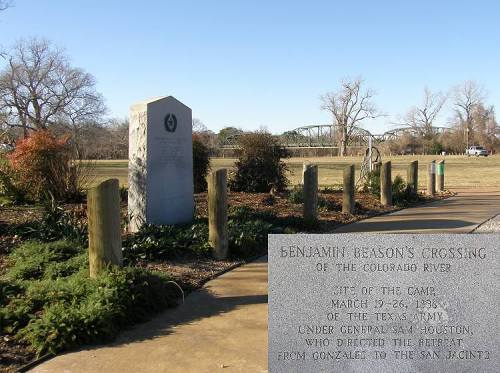 |
|
The
Texans crossed the Colorado River and marched 20 miles down the
east bank to Benjamin Beason’s crossing near present-day Columbus,
where they pitched camp on March 20. Had they been a few
miles further south, the troops may well have heard the distant
rumble of gunfire. On March 19,
Colonel James Walker Fannin was defeated at Coleto Creek by the
forces of General Jose Urrea. Fannin surrendered, and on Palm Sunday,
March 27, 352 Texans were marched out of the Presidio La Bahia at
Goliad and cruelly executed at the order of Santa Anna.
With the news of the massacre,
Houston’s men
rose as one and demanded an immediate attack on the Mexican army.
How else could they hope to avenge the loss of so many good friends
and family at the Alamo
and now Goliad?
Refusing to justify his decision, Houston
ignored their demands and ordered a withdrawal to the Brazos. On
March 28, the army arrived at San
Felipe de Austin on the west bank of the river, then crossed
over and marched to the plantation of Jared Groce where they set
up camp and drilled for two weeks.
Sam Houston’s
men were not alone when it came to urging him to fight. In mid-March,
the ad interim Texas government fled to Harrisburg from Washington-on-the-Brazos
when they learned of the Mexican army's approach. Interim President
David G. Burnet sent Houston
a letter demanding that he stop his retreat and fight. Burnet also
sent the Secretary of War, Thomas J. Rusk, to try and convince Houston
to take a more aggressive course. Houston,
however, much to the frustration of his army and the government,
also refused this request and stuck to his original plan, which
he continued to keep to himself.
Since Houston
appeared unwilling to put up a fight, Santa Anna decided to go after
the Texas government. After crossing the Brazos River at Fort Bend,
near present-day Richmond,
on April 11, he headed down the road for Harrisburg with
700 men, unwisely dividing the remainder of his forces so that he
might move more rapidly. General Urrea was at Matagorda
with 700 men, Colonel Gaona was between Bastrop
and San
Felipe with 725 men, Colonel Sesma had 100 men at Fort Bend,
and Colonel Filisola, with nearly 1800 men, was somewhere between
San
Felipe and Fort Bend.
When Santa Anna arrived at Harrisburg on April 15, he learned
that the Burnet government had fled down Buffalo Bayou to New Washington
(now Morgan’s
Point). Burning Harrisburg to the ground in anger and frustration,
the dictator hurriedly followed, but when he reached New Washington
on April 19, he discovered the government had once again fled, this
time toward Galveston.
Santa Anna then set out for Anahuac
by way of Lynchburg, but his advance elements got there just in
time to see the government officials sail away.
Meanwhile, Sam Houston
was determined he would not fight a battle until he reached ground
of his own choosing. He moved his army across the Brazos and headed
east, burning farms and crops as he went. There were few towns and
supply centers between San
Antonio and the eastern settlements, and when the Mexicans’
food and ammunition ran low, Houston
intended to make sure it would be impossible for them to secure
more. This strategy failed to satisfy the Texans, and they continued
to grumble their displeasure as the army marched eastward.
On April 17, the Texas army reached a settlement known as
“New Kentucky”
where two wagon trails crossed; one trail led to Harrisburg and
the other toward the Sabine
River. Most of Houston’s
officers and men had come to think of him as too timid to fight,
and they believed he would lead the army toward the Sabine,
where United States troops under the command of General Pendelton
Gaines waited to hopefully bail the Texans out if it became necessary.
However, much to the satisfaction of these non-believers, Houston
moved the column down the Harrisburg road.
From two prisoners captured by scout Deaf
Smith on April 18, Houston
learned that the Mexicans had burned Harrisburg and were following
the west bank of the San Jacinto River. He also heard that Santa
Anna himself commanded the column, and more importantly, that the
Mexicans had been forced by high water to cross the bridge over
Vince’s Bayou and would have to cross the same bridge on their return.
After considering the situation, Houston told the Texans they would
soon see action and to “Remember the Alamo!” and “Remember
Goliad!"
|
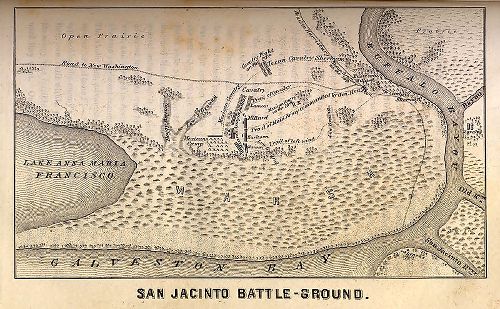 |
|
San Jacinto
Battle Ground Map
Wikimedia Commons
|
|
At
dawn on April 20, the Texans resumed their march, hoping
to arrive at Lynch’s Ferry before Santa Anna. Houston
sent an advance party to the ferry, and they found it guarded by
only a few Mexican soldiers. The Mexicans fled at the sight of the
Texans and left behind a flatboat loaded with provisions that were
most likely taken as plunder from Harrisburg. Capturing the provisions
was fortunate because the Texans had little supply of their own.
The Texans set up camp along a stretch of rising ground that ran
parallel to the bayou and was protected by a skirt of timber. The
“Twin Sisters”,
two cannons that were a gift from the citizens of Cincinnati, were
placed in the center under Colonel Neill. The first regiment of
riflemen commanded by Colonel Burleson camped on the right, and
the second regiment under Colonel Sherman set up on the left. The
cavalry was camped in the center at the rear of the infantry. The
Mexican camp stood less than a mile from the Texas camp. A marsh
spread out to the Mexicans' rear, and a temporary breastwork of
trunks, baggage, and other equipment protected their front.
That afternoon, a small detachment of cavalry commanded by Colonel
Sidney Sherman skirmished with some Mexican infantry. In the clash,
which almost brought the opponents to open battle, two Texans were
wounded, one severely and one mortally, and several horses were
killed. Mexican casualties were much heavier. Mirabeau Lamar, a
private from Georgia and later President of the Republic of Texas,
distinguished himself in the fighting and was placed in command
of the Texas cavalry on the eve of the battle.
|
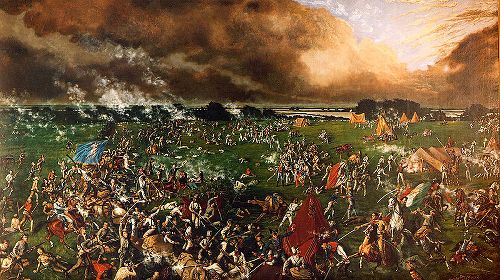 |
Battle of San
Jacinto Painting 1895 by Henry Arthur McArdle
Courtesy Texas State Library and Archives Commission. Wikimedia Commons
|
|
The
morning of Thursday, April 21, dawned bright and clear. Refreshed
from a good night’s rest and a breakfast of bread made with flour
captured from the Mexicans and meat from freshly slaughtered cattle,
the Texans were more than eager to launch an attack. They could
see the Mexican flags waving in the freshening morning breeze and
hear the mournful notes of the enemy’s bugle calls.
About 9 A.M., Deaf
Smith and his scouts discovered that, during the early morning,
General Cos had crossed Vince’s bridge with nearly 600 troops, increasing
Santa Anna’s strength to more than 1200. In response, Houston
ordered Smith
to destroy the bridge. The bridge’s destruction would not only prevent
Santa Anna from receiving further reinforcements, but also make
it impossible for either the Texans or the Mexicans to retreat toward
Harrisburg. Normally, Vince’s Bayou was about 50 feet wide and ten
feet deep, but heavy April rains had swollen it to a much more daunting
obstacle.
After his battle plan was approved by Secretary of War Rusk, Houston
formed the Texas army for battle around 3:30 in the afternoon. The
Texans’ movements were screened from the Mexican position by trees
and the rising ground that stretched between the positions. All
was quiet on the Mexican side during the afternoon siesta, and Santa
Anna had neglected to post any lookouts. The Texans formed their
line of battle with Burleson’s regiment in the center, Sherman’s
regiment on the left, the artillery, including the “Twin
Sisters,” under George Hockley on the right, and the infantry
under Henry Millard to the right of the artillery. The cavalry under
the command of Mirabeau Lamar formed on the extreme right.
At General Sam Houston’s
command, a battle line 910 strong advanced silently out of the woods
and swept up and over the long rise. Bearded, dirty, and ragged
the Texans may have been, but their long rifles were clean and well
oiled, and their features were set with grim determination. The
few musicians piped “Will you come to the Bower,” a popular love
ballad of the day, the men bending low as if preparing to face a
strong wind. As the troops advanced, Deaf
Smith galloped up and informed Houston
that Vince’s Bridge had been destroyed. The word spread quickly.
There would be no retreat. It was victory or death.
|
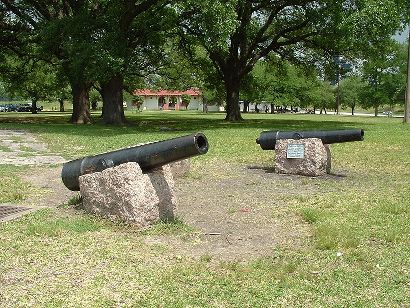 |
As
the range to the Mexican lines closed, the “Twin
Sisters” moved up and opened fire, sending a blistering load of
grapeshot boiling into the enemy barricade. With the roaring blast
of the cannons, the Texans surged forward as one man, screaming “Remember
the Alamo!” and “Remember Goliad!” Blazing away with their
long rifles at nearly point blank range, they stormed over the makeshift
Mexican barricade, emptied their pistols, and then went at the Mexicans
hand-to-hand, using their rifles as clubs and slashing right and left
with their deadly long knives. The terrified Mexicans either fell
where they stood or ran in panic from the savage fury of the Texas
assault.
Hysterical pleas of “Me no Alamo!” and “Me no Goliad!”
echoed across the battlefield, but there would be no mercy tendered
this day. The enraged Texans quickly reloaded their long rifles and
went after the fleeing Mexicans, shooting, clubbing, or stabbing to
death any man they could catch. The terrorized Mexicans fled into
the boggy marshes at the rear of their position, but the bloodthirsty
Texans followed them even there, determined to kill every last man.
The water ran red with the blood of the slain. General
Houston, his ankle shattered by a Mexican musket ball, did his
best to call a halt to the senseless killing, but the fury of the
Texans knew no bounds and the massacre continued.
Sheer exhaustion finally brought an end to the slaughter, and Sam
Houston rode slowly from the field of victory. At the foot of
the oak tree where he had slept the previous night, the commander
of the Texas army slid off his horse and collapsed into the arms of
his chief of staff, Major Hockley. According to the official report
of the battle, 630 Mexican soldiers were killed, 208 wounded, and
730 taken prisoner. Balanced against this terrible toll, the Texans
suffered only nine killed, most of them in the initial Mexican volley,
and thirty wounded. In addition, the Texans captured a large supply
of weapons, ample stocks of supplies, and $12,000 in silver. |
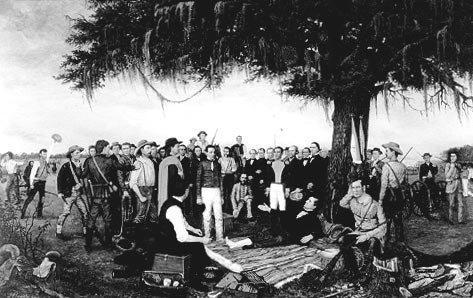 |
"Surrender
of Santa Anna” 1886 painting by William Huddle
Wikimedia
Commons |
|
Much
to Sam Houston’s
disgust, General Santa Anna had disappeared during the battle. The
following morning Houston
ordered a search of the surrounding area. That afternoon, Sergeant
J. A. Sylvester took note of a Mexican running toward Vince’s Bayou.
He caught the man hiding in some high grass. The prisoner was dressed
in a common soldier’s uniform, but when Sylvester took him to the
camp, the other prisoners recognized him and cried, “El Presidente!”
Santa Anna was brought to General
Houston, who was still lying under the same oak tree nursing
his wounded ankle. Houston
made it plain that he held no like for the dictator, and the Texas
soldiers crowded around him growling angry threats. Terrified, Santa
Anna whined, “You can afford to be generous, you have captured
the Napoleon of the West.” Houston retorted angrily, “What
claim have you to mercy, when you showed none at the Alamo or at
Goliad?” The two men sparred verbally for nearly two hours,
but in the end Santa Anna agreed to write an order commanding all
Mexican troops to evacuate Texas.
Later, Santa Anna signed the treaties
of Velasco, one open to public scrutiny and one executed in
secret, which recognized Texas independence. In eighteen glorious
minutes, Sam Houston
and his fellow Texans won a remarkable victory, establishing Texas
as an independent republic and opening the door for United States
expansion southwest to the Rio Grande and all the way west to the
Pacific Ocean. Few battles in history have been more decisive or
have had more far-reaching consequences than the Battle of San Jacinto.
© Jeffery
Robenalt April 1, 2012 Column
jeffrobenalt@yahoo.com
References for "The
Battle of San Jacinto" >
More Battle of San
Jacinto - Related Articles
More "A Glimpse of Texas
Past"
|
Battle of San
Jacinto - Related Articles
The
Battle of San Jacinto April 21, 1836 by Murray Montgomery
Battle
of San Jacinto by Archie P. McDonald ("All Things Historical")
Lost
Letters from Travis' Saddlebags Spark Outrage by Mike Cox
San
Jacinto Day by Archie P. McDonald ("All Things Historical"
)
News of the fall of the Alamo on March 6, 1836, and the execution
of Texians captured at Goliad three weeks later, produced the terrible
Runaway Scrape, a mad flight of refugees who scrambled eastward
to escape a similar fate at the hand of General Antonio Lopez de
Santa Anna’s armies. In the midst of these troubles, one man, Sam
Houston, rode west...
Baker
Talk by Mike Cox ("Texas Tales")
"In modern times, battles begin with precision air strikes.
In the 19th century, battles began with stirring speeches. Sometime
in the early 1900s, the Beeville Picayune published the talk Captain
Mosley Baker supposedly gave to the men of his company at San Jacinto
on April 21, 1836..."
The
Top Ten Facts About The Construction of The San Jacinto Monument
San
Jacinto Monument by Mike Cox ("Texas Tales")
"Most people think the towering star-topped limestone monument,
built during the Texas Centennial in 1936, is the only San Jacinto
monument. Actually, it’s only the biggest."
Alfonso
(Alphonso) Steele - Last Texas survivor of the battle of San
Jacinto, and a State Park dedicated to him
The
Last Hero by Bob Bowman ("All Things Historical" )
The last surviving veteran of the Battle of San Jacinto on April
21, 1836, lies in an almost forgotten cemetery in deep East Texas
A
Frenchman at San Jacinto by Bob Bowman
Charles Cronea, a Jean Lafitte pirate who fought at the Battle of
San Jacinto.
The
Treaty of Velasco by Archie P. McDonald ("All Things Historical"
)
General Sam Houston, and later Interim President David G. Burnett,
chose negotiation instead of revenge for the massacres at the Alamo
and Goliad.
Twin
Sisters by Mike Cox ("Texas Tales")
The most famous pieces of artillery in Texas history
Smiths
at San Jacinto by Mike Cox ("Texas Tales")
Enoch K. Smith may have been the 17th Smith who took part in the
Battle of San Jacinto.
The
Mysterious Yellow Rose of Texas by Linda Kirkpatrick
A
Dalliance to Remember by Clay Coppedge
The
Yellow Rose of Texas by Barbara Duvall Wesolek
|
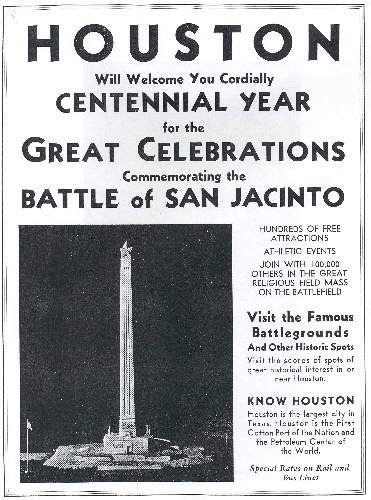 |
References
for "The Battle of San Jacinto"
|
|
Davis, William
C. (2004), Lone Star Rising: The Revolutionary Birth of the Texas
Republic, Free Press, ISBN 0-684-86510-6.
Fehrenbach,
T.R. (2000), Lone Star: A History of Texas and Texans, Cambridge:
Da Capo Press, ISBN 306-80942-7.
Groneman, Bill
(1998), Battlefields of Texas, Plano, TX: Republic of Texas
Press, ISBN 97815566225110.
Hardin, Stephen
L. (1994), Texian Illiad - A Military History of the Texas Revolution,
Austin, TX: University of Texas Press, ISBN 0292730861.
Kemp, L.W.
"San Jacinto, Battle of," Handbook of Texas Online, (http//www.tshaonline.org/handbook/online/articles/qes03),
January 8, 2012. Published by the Texas State Historical Association.
Maher, Ramona;
Gammell, Stephen; Rohr, John A. (1974), The Glory Horse: The
Battle of San Jacinto and Texas in 1836, Coward, McCann, & Geoghegan,
ISBN 9780698202945.
Moore, Stephen
L. (2004), Eighteen Minutes: The Battle of San Jacinto and the
Texas Independence Campaign, Rowan & Littlefield, ISBN 9781589070097.
Todish, Timothy
J. ; Todish, Terry; Spring, Ted (1998), Alamo Sourcebook, 1836:
A Comprehensive Guide to the Battle of the Alamo and the Texas Revolution,
Austin, TX, Eakin Press, ISBN 9781571681522.
|
|
|
